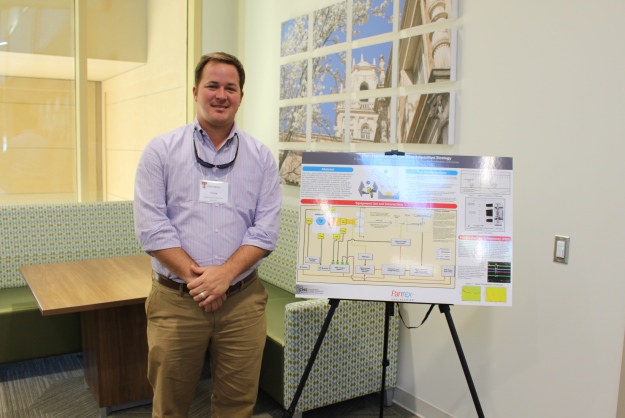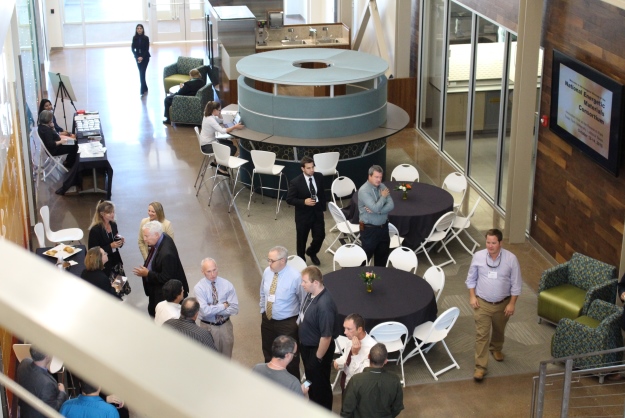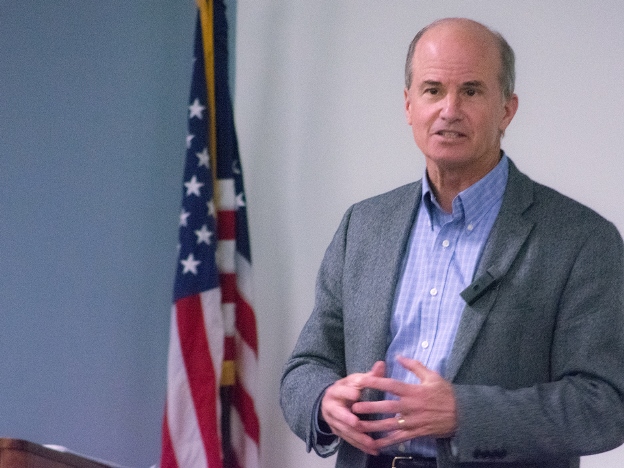Pantex Blog
Successful W87 Flight Test used CNS-made components

A W87/MK21 Flight Test was successfully launched from Vandenberg Air Force Base in late October. The Minuteman III missile carried a single, hi fidelity W87/MK21 Joint Test Assembly and was launched using standard ground launch procedures. The JTA re-entry vehicle was targeted and successfully detonated in the Vicinity of Illeginni at the Reagan Test Site, Kwajalein Atoll.
CNS employees at Y-12 built the canned subassembly (with surrogate material replacing special nuclear material), and Pantex produced the high explosives and assembled the final weapon for this test. In the absence of nuclear testing, JTAs are an essential component of our ability to ensure the effectiveness of stockpile nuclear weapons. They prove that all non-special nuclear material components of the weapons and their launch systems work as designed.
CNS represented at inaugural Energetics Consortium

About 70 university researchers and government and industry experts from across the country, including Consolidated Nuclear Security employees, joined forces at the first ever National Energetic Materials Consortium hosted by Texas Tech University.
Pantex’s Christopher Young said, “There are a great many types of energetic materials and an array of applications. The explosives used by the Department of Energy are a specialized subset and have very stringent requirements in regards to their precision, timing, reproducibility, sensitivity and ageing characteristics.”
NEMC was formed by leading universities across the U.S. to combine technology and science within the academic community with the manufacturing resources of private industry. The aim is to bring critically needed innovations to the energetics sector of the national technological industrial base; NEMC is designed to allow for a rapid transition of new materials to a modernized industrial base.
“Acceptance and performance testing of explosives has been accomplished at Pantex for DOE since the 1960s,” Young said. “We’ve teamed up with Los Alamos National Laboratory and Lawrence Livermore National Laboratory on this work. Current data acquisition strategies are continuously balanced against new technologies and ever evolving requirements.”
There was a strong showing from Pantex and Y 12 presenters.

Pantexan Patrick Goguen said, “It was a great opportunity to share ideas with some of the leaders in academia, government and industry related to advancing the frontiers of energetic materials. Rarely can you get such a diverse audience together to have such a focused interchange.”
CNS was one of the sponsors of the event, held in Lubbock, Texas, and is collaborating with Texas Tech University in research and development areas.
Former Strategic Command chief emphasizes importance of Pantex, Y-12 missions
Gen. Kevin Chilton, former commander of U.S. Strategic Command, recently spoke to Pantex employees and delivered a clear message: “From the bottom of my heart, thank you for what you do every single day.” During the Jan. 26 all hands address, he encouraged employees to be proud of themselves, calling the mission “unique,” “vital” and “special.”

Chilton, who is now working with Consolidated Nuclear Security to support Pantex and Y 12 missions, was at Pantex as a member of a Technical Advisory Board focused on enhancing mission delivery. His talk with employees emphasized the importance of the CNS mission, linking employees’ roles to the broader nuclear deterrent.
“One thing I’m certain of, folks, is that we in this room, our children, grandchildren and great-grandchildren will absolutely need and depend on every one of you and the work you do to provide security for them and our great country,” he said. “For that and your dedicated and hard work, I thank you again.”
And he noted that more work will be coming to Pantex and Y 12 as nuclear weapons work ramps up in the coming decades.
“The cycle is picking up right now, and it’s picking up fast. There is a tremendous amount of work to be done, and there are those who doubt we can do it,” Chilton said. “And then there are those like me who are counting on folks like you to make it happen because we have to make it happen. It’s just so important to our country.”
In addition to thanking employees for their work, Chilton explained that the purpose of the United States’ nuclear stockpile is to deter and assure — deter those who think striking us wouldn’t be so bad and assure our allies that the U.S. can provide protection. Chilton said our nation has used nuclear weapons as a deterrent every day since they were first fielded. “We have been 100 percent successful,” he noted.
Aside from stressing the importance of a strong nuclear deterrent and the role CNS plays, he peppered his remarks with stories of his days as the commander of STRATCOM, his long and prestigious Air Force career and his service at NASA, where he was on three space shuttle missions: Endeavour (1992), Endeavour (1994) and Atlantis (1996), which he commanded.
EMInS improves communications during emergencies
Pantex Emergency Management just received a giant communications boost with the installation of the Emergency Management Information System, or EMInS. Y 12, the Pantex sister site, has used EMInS for many years. The addition at Pantex brings the two sites closer in their management of emergency events.

Pantex Emergency Services now uses the Emergency Management Information System, or EMInS. From left: Maribel Martinez, Brenda Graham and Greg Roddahl.
“Pantex and Y-12 are required to maintain an Emergency Management Department to oversee activities needed during an emergency that may affect employees, the public or the environment,” said Daniel Gleaves, Emergency Services senior manager at Pantex. “Y-12 has an outstanding Emergency Management Department, and EMInS is one of the primary reasons.”
EMInS is an interactive computer program used to provide real-time information, data, graphics, maps and video capabilities necessary to efficiently manage an emergency. The software provides a structured means of recording emergency information and sharing it among Emergency Response Organization cadre members.
Maribel Martinez, Emergency Management Program section manager said, “The implementation of EMInS at Pantex starts the integration of resources, datasets and information throughout Pantex and Y-12. These improvements are designed to enhance coordination efforts. It is a tool our ERO can use to ensure constant situational awareness and helps to create a common operating picture to improve our operations and information processes to ensure the safety of our employees and our neighbors.”
The Pantex EM team works closely with its National Nuclear Security Administration counterparts to continuously revitalize the ERO.
Gleaves said, “We continually review our plans to look for improvement opportunities. EMInS is one of those opportunities. Using this system will allow us to communicate all issues involved in an emergency. Team members can discuss specific issues on private team boards or submit updates, questions or suggested media facts to appropriate EMInS users.”
A phased implementation of EMInS capabilities will allow state and local agencies some access to the system. These agencies participate in Pantex drills and exercises and would respond in the event of a real emergency. EMInS will help in coordination of response efforts and information flow; this will improve communication and performance.
“We recently provided EMInS training to members of the ERO team followed by a drill.” Gleaves said. “We were very pleased with the outcome and look forward to showing how the software enhances our performance during upcoming drills and exercises,” he added.
Pantexans help students ‘bee’lieve in math

A recent Pantex volunteer event wasn’t as easy as 1-2-3 because convincing students that math is a useful skill is difficult, but Pantexans Dee and Scott Weaver were up for the task. The couple led a team of Pantex employees to help about 40 students at the High Plains Children’s Home gain a better understanding of math. Other Pantexans on the team included Laureen Kelly, Tamara Schaef and Leticia Rodriguez. The Weaver’s grandsons, Weston and Ryder, also attended.
“Sometimes it is difficult for students to recognize how much math is used daily,” said Dee Weaver. “When you start looking, math is all around us.” To prove this point, Scott Weaver, a beekeeper, presented “Beekeeping by the Numbers.”
“The kids were fascinated by the information about bees,” Dee said. “It emphasized that math is found in nature in many different ways – from the shape of the honeycomb chambers to the distance a bee will fly to and from the hive.”
At the end of the day, the teams presented graphing calculators to three high school students. “The calculators will help them with their homework and help them stay up with their classmates,” Dee said. “It is one less hurdle they have to overcome to help them be successful in the higher‑level math classes.”
